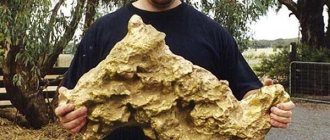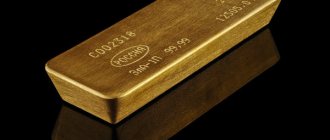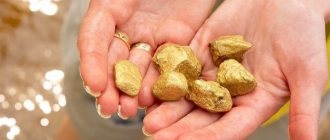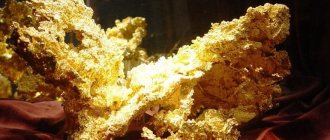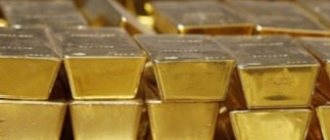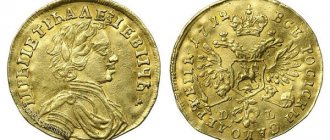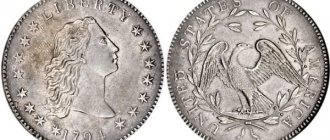Adviсe
- All that glitters is not gold
- Iodine test
- Magnet check
- Vinegar test
- By the tooth
- Determining the authenticity of gold using analytical instruments
- Determination of product weight and density
- Silver test
The fear of being deceived haunts many people, and this fear is not unfounded. According to statistics, over the past 10 years the production of precious metals has practically not increased, but at the same time the number of jewelry stores is growing at an incredible pace. Alas, even when buying jewelry in a jewelry store, there is a chance of running into a low-quality fake. Are you overcome by doubts? Verifying the authenticity of precious metals is available not only to specialists, but to each of us. There are many ways to do this, which can be done at home.
Metal detector: purpose and principle of operation
A metal detector for gold is a device that indicates the location of metal with different compositions in the ground or water. The equipment records the reflected signal, similar to an echo sounder. Based on the response signal, it determines whether there is a particular metal under the search detector.
For proper functioning, you need a receiving and transmitting antenna. Metal detectors operating according to the VLF and PI schemes have combined antennas, which are called a coil or frame. To catch a signal, the coil must be moved.
RF-powered metal detectors have 2 coils located about half a meter apart from each other. During operation, they do not require constant displacement. There is another type of equipment - pinpointers, which are called precision pointers. They are able to catch interruptions and changes in the eddy current emitted by a metal object.
Table: types of metal detector devices, pros and cons
| Device type | pros | Minuses |
| VLF | - finds small objects; — discrimination allows you to exclude objects with a certain conductivity from the search. | — limited depth of object detection. — the maximum detection depth is 60 cm. |
| P.I. | — there is discrimination based on the size of objects; - designed for greater depth. | — conductivity interference cannot be ruled out |
| RF | - finds objects at depth; - designed for searching for large objects | — no discrimination; |
Metal detector Garrett AT Gold
Metal detectors for gold: types and specifics
Not all metal detectors are the same. To see the difference, you need to study the characteristics of the device. High frequencies, more than 14 kHz, are important for searching for small objects.
All search equipment can be divided into universal or specialized. The first type is suitable for various metals, including precious stones. There is a wide range of options here, and it is possible to make custom settings.
Specialized equipment is being developed to determine gold in conditions where this is difficult to do. Such equipment can cost a lot of money, which means it is used only by professionals. An example of such technology is the demon-yu electrochemical detector from Ultramag.
Its task is to establish the authenticity of precious products, non-ferrous and ferrous metals, etc. The device is used in Russia, Ukraine and many other countries.
Beach
The purpose of such equipment is to find precious metals on a fresh or salt beach. The metal detector must be protected from water and have high ground balance. Such requirements are associated with high mineralization of the soil, which makes searching difficult. Therefore, the device must distinguish between signals emanating from ferrous metal and directly from the precious metal.
Not all metal detectors see gold the same way
Water
Precious jewelry is often hidden at knee depth. To do this, the gold detector must have a waterproof coil and a protected housing. It is possible to search for precious metals at a depth of up to 3 meters. To hear the sound of the device, it is better to use special headphones.
Mechanical methods
The basis of such methods is knowledge about the physical properties of gold and its alloys. A gold product makes a specific sound when falling, is not magnetic, and has a certain density. There are instruments that determine the composition of the alloy and its sample based on electrical conductivity.
Electronic detector
A device for assessing the quality of an alloy is quite expensive and is rare. The detector also uses a reagent designed for a certain number of reactions. For single checks of the authenticity of jewelry, its use is too expensive.
The device itself determines the following indicators:
- type of metal;
- alloy composition;
- ligature share;
- sample
Some devices work in the cut. In others, the sensor is applied to the surface of the product. There are mobile devices with a battery and those operating from the network.
The most popular of them is the DeMon electrochemical detector. It performs a quick analysis by assessing the electrochemical potential of a surface. During inspection, no cuts are made, which means the appearance of the decoration is preserved. A few square millimeters of area are sufficient to measure. Using DeMon, you can determine the homogeneity of the alloy and its sample by applying the sensor at different points. By the way, here is a video of how this device works.
Assay needles or touchstone
A touchstone is a black plate on which a line is drawn with a noble metal and the sample is determined by its color. To make it, take a block of siliceous slate, such as black jasper.
The plate serves as a background for determining the composition of the alloy. A line is drawn on the stone with pressure on the product being examined. A strip is drawn nearby using a special assay needle that comes with the stone. A standard set of needles includes six rods with sample standards from 333 to 999.
The alloy sample is preliminarily determined by the saturation of the strip. Then use a glass rod to drip the reagent onto the rubbed areas. The chemical reaction occurs only with the ligature. The final conclusion is made based on the degree of oxidation. The darker the color, the lower the gold content and the lower the purity.
Compared to sawing, this is a gentle method. It is relevant and less destructive for small products.
How to clean a touchstone
After the checks have been carried out, the surface of the stone is mechanically cleaned of any leftover cuts, reaction residues, and sediment formed. The stone is lubricated with nut, almond or cedar oil, then wiped dry.
Archimedes' method
It is based on the dependence discovered by Archimedes of the density of a substance on the water it displaces. Data from weighing the product in water and air are substituted into the formula. Even a small error in calculations affects the result. The method is troublesome and is used quite rarely.
Hydrostatic weighing is relevant for massive objects without cavities or voids. At home, you can put the product in a glass of water. Gold has a fairly high density coefficient compared to other metals and sinks quickly.
Magnet
Precious metals are not magnetic. However, non-ferrous metals - copper, aluminum, brass - also do not react to magnets. Therefore, the method will not reliably show the quality of the gold product, and therefore its purity.
If you have a magnet on hand, you can attach it to the jewelry. Surfaces will be attracted if the alloy has a high iron content or gold plating is applied to a base magnetic metal.
Sound
Monolithic products can be checked by the sound with which they hit a hard, smooth surface. A table, tiles, laminate will do. Gold falls with a ringing clear sound. If the sound is low or dull, it means that something other than gold has fallen or there is a foreign inclusion inside the product.
The method is not very reliable; it will not be possible to accurately determine the sample. This way you can only indirectly judge what metal the product is made of. Only a person with keen hearing can hear the differences in sound. The method is generally not suitable for testing ingots and chains.
Scratches
If you scratch the jewelry with a sharp object or a small file, you can identify a fake with a thin layer of gold plating. There will be a noticeable change in color within the product.
If the coating is thick enough, you won’t be able to reach the inside of the product with a scratch. You can use a professional diamond-coated needle file. The main thing is not to overdo it - too deep a cut will damage the appearance of the product, and small scratches can be easily removed by polishing.
Swipe gold over tile or unglazed porcelain
This method reliably determines whether the product is gold, but does not reveal its purity. For the test you will need unfired ceramics, porcelain without glaze. A piece of ceramic tile or dishes will do.
Using the product being tested, you need to draw a stripe on the ceramic. The precious metal will leave a golden mark. The base metal will leave a gray, black trace.
Requirements for an effective metal detector for gold prospecting
When choosing a metal detector, the following indicators are important:
- quality of goal separation;
- size of found objects;
- depth;
- soil rebuilding.
Qualitative target separation and discrimination
A high-quality detector should distinguish gold from iron. Devices with vDI from 0 to 99 show vDI of precious metal from 40-45, while ferrous metal - no more than 30. The signal of precious metal can be given by metal affected by severe corrosion.
Eliminating interference is the task of discrimination. The more thin bars the scale contains, the less chance of getting a false signal.
Magnitude of discrimination target
The indicator depends on the frequency at which the search is carried out. The higher the frequency, the smaller the wave, which means the smaller objects can be found. The minimum acceptable frequency for gold miners is 14 kHz.
Metal detector Makro Kruzer Gold
Search depth
The greater the depth indicator allowed for the device, the better. This creates a greater chance of finding deposits lying at depths of more than half a meter.
Setting up ground balance
The indicator can be adjusted automatically or manually. It's better when there is manual and automatic balance at the same time. This way there is less chance of catching false signals.
Methods for determining silver in a store
What the jewelry is made of can be determined with an accuracy of up to 80% when purchasing the product. Squeeze the thing in your hand and wait for it to warm up. Precious metal always weighs a lot, aluminum, on the contrary, is as light as feathers. Therefore, if in front of you there is supposedly a silver spoon, but it weighs suspiciously little, then your fears are not in vain. Don't overpay for a fake.
Also inspect the product. If zinc is hidden inside, a noticeable dark coating will remain on your hands. Inspect the surface of the decoration inside. If a precious metal is present, it is always stamped with a breakdown. The stamp has clear boundaries and the numbers are clearly visible. The stamp with the hallmark is located clearly in the middle, the same distance is maintained from one and the other edge.
Metal detector pricing factors. Price range
Factors taken into account when pricing are:
- the model was made to search for gold or such a function was obtained by increasing frequencies;
- marketing costs;
- how recognizable the manufacturer is;
- equipment of the device.
Metal detectors for searching for gold vary depending on the following price categories:
- 7 - 15 thousand rubles. - the equipment is designed to search for ordinary metal;
- 16 - 30 thousand rubles. — some models are able to find nuggets;
- 31 - 60 thousand rubles. — models designed for silver, gold;
- More than 60 thousand rubles. - a technique used by professionals.
Table: TOP 10 effective metal detectors. Comparison of characteristics
The top best devices included 10 metal detectors in the price category from 15 to 50 thousand rubles. The rating is based on user ratings.
| Model | Description | Average cost, rubles |
| Makro Kruzer Gold | The most modern apparatus for searching for precious metals. Is a ground and underwater equipment. The kit includes 2 waterproof coils, a wireless headset, and a charger. There is a rechargeable battery with the ability to connect to a power bank. There is a discriminator, manual and automatic ground balancing. The best option for finding status gold by professionals. | 41 650 |
| Minelab X-Terra 505 DD | A good universal ground high-frequency metal detector. There is a discriminator, ergonomics are thought out. Balancing must be adjusted independently, which requires certain user skills. | 28 990 |
| Garrett ACE 400i | There is automatic ground balancing. The search for nuggets and gold occurs at a frequency of 10 kHz. The model is considered a ground model, but has decent moisture protection for the coil. The product comes with a rich set of accessories: headphones, cases, a CD with instructions in 2 languages. | 25 950 |
| Fisher F75 | Equipped with an elliptical-shaped coil, waterproof, automatic and manual balancing. Operation is carried out at frequencies up to 13 kHz. You can adjust the sensitivity. The model is capable of recognizing coins at a depth of up to 50 cm. | 37 950 |
| Fisher F4 | Unmistakably distinguishes between non-ferrous and ferrous metals at shallow depths. Includes 11”DDBiAxial reel with moisture protection. Power is provided by 2 crown batteries that last up to 30 hours. There is a discriminator, a headphone jack, a speaker and an armrest. You can adjust sensitivity and tone identification. Product weight – 1.4 kg. | 25 200 |
| Minelab GOLD MONSTER 1000 | Designed to find 999 fine items. The device is equipped with two 10"x6" DD, 5" DD coils, headphones, a battery box and a power supply. The model is ground, with moisture protection for the coil. The VLF detection method finds gold grains and nuggets. There is a discriminator, automatic balancing, tone identification and sensitivity adjustment. Weight – 1.33 kg. | 62 900 |
| Garrett AT Gold | Refers to budget professional equipment. A standard coil is available that provides accurate detection at high frequencies up to 18 kHz. There is a discriminator, sensitivity adjustment, headphone jack and speaker. Operation is provided by 4 AA batteries. | 39 650 |
| Minelab X-Terra 305 New | A modified model of a familiar budget device. The device was equipped with another VFLEX detection method, working on VLF technology. Minelab X-Terra should respond to gems in the ground without noticing interference. The company has improved ergonomic indicators, but has left almost no technical specifications. | 19 990 |
| Garrett GTI 2500 | An inexpensive version of the device with manual and automatic ground balancing. Search frequency 7.2 kHz. There is a display showing the current user settings. The device runs on rechargeable batteries. Can be used by lovers of gold status goldie black metal. Refers to ground devices, has a lot of weight. | 20 950 |
| Minelab X-Terra 305 | Made in Australia. The gold reserve distinguishes without errors. Has different search frequencies. Minelab is equipped with a conventional coil, but it does its job perfectly. There is manual balancing, a discriminator and a headset input. Operation is ensured by rechargeable batteries. | 18 450 |
Metal detector Minelab X-Terra 305
All that glitters is not gold
Only a jeweler who has all the necessary analytical equipment can check a gold item and issue a reliable conclusion as to whether it belongs to a noble metal. Professional verification is carried out by the Assay Chamber. Examination of gold jewelry is not a cheap pleasure; the price of the service ranges from 10 to 20% of the estimated value of the item. Gold is being counterfeited more and more often, and no one wants to waste money. By the way, the need to check gold for authenticity may arise not only in relation to jewelry, but also, for example, when purchasing bars or nuggets.
Silver earrings with cubic zirconia, SL; (price on the link)
The most difficult type of counterfeit to independently identify gold is a piece of jewelry on which a thin layer of precious metal is applied. It is extremely difficult to determine the authenticity of such work at home without causing damage to the product.
The most common methods of counterfeiting gold items:
- surface gilding;
- replacement with copper;
- alloys of aluminum and other metals;
- an alloy of titanium and gold.
Fake jewelry made from alloys similar in color to gold leave spots on the skin with a green tint, especially when the ring is worn for a long time. The substitution of less valuable metal alloys for gold by others or similar deposition can be determined using well-known methods.
The first stage is checking gold by comparison. Surely you have a piece of jewelry whose authenticity you have no doubt about. A line should be drawn on a hard object with these two decorations. Gold items will leave the same mark, but if there are differences, this is a direct reason to doubt the quality.
Using a magnifying glass, look closely at the mark, which should reflect the gold standard. It should be clear and without damage.
The cost of a gram of gold changes daily, however, you should rely on it when purchasing jewelry, even if it is not purchased in a store.
Gold ring with diamonds and citrines, SL; gold earrings with diamonds and citrines, SL; (price on the link)
There is also an opinion that sound helps to identify a copy. Gold items emit a crystal ringing sound when they hit a hard surface. A dull or any other sound is a cause for concern.
Iodine test
Iodine can change the color of most components that are used to falsify precious metal, but this test is completely harmless for jewelry with a purity above 500 (i.e., which contains more than 50 mass percent gold).
A drop of pharmaceutical alcohol solution of iodine should be applied to the product that is in doubt, and after 10-15 seconds, remove its remains with a napkin. If a trace of iodine remains, then this is not a gold product. Unaltered metal color may indicate authenticity.
Magnet check
Precious metals are not affected by magnets. Steel products coated with a thin layer of gold will instantly be attracted to the surface of a magnet; real gold jewelry will not react to a magnet.
Many manufacturers use lock designs for chains and bracelets that include a steel spring - in this case, the magnet will only attract the lock.
Indifference to a magnet is a necessary condition, but not a sufficient one. For example, most alloys of copper and tin are non-magnetic. However, such products are much lighter: the difference in weight can be felt even without an analytical balance.
Vinegar test
A cheap fake will turn black when exposed to acetic acid. If you put gold with a purity above 500 into it, then nothing will happen to it. This is another surefire method of recognizing authenticity. 3-5 minutes is enough to conduct the experiment.
By the tooth
You've probably seen in films how the main characters tried a gold coin "by tooth." This method is only suitable for high-grade gold (whiter than 900), which is relatively soft. On such gold, teeth marks will definitely remain, since its hardness is much lower than that of other metals.
Determining the authenticity of gold using analytical instruments
Instant identification of metal components at home is possible using a special device called a metal analyzer. The result is displayed on the screen within 2-3 seconds. To obtain it, you need to point the device at the object under study. The analyzer is widely used by precious metal miners.
Gold earrings with diamonds and sapphires, SL; (price on the link)
In order not to doubt the authenticity of gold jewelry, you should choose the right place to purchase it. Jewelry stores and pawn shops are selling points for real precious metals. Buying second hand is always a risk.
Where is the best place to start looking for gold?
If gold-bearing places are far away and there is no way to get there, you can try your luck in nature. People often go to parks, beaches, and also often lose jewelry there. The gold miner will be able to test his equipment and try out different settings and functions. But it is important to remember the legal side of the issue and responsibility.
It is better to study the law and the area before starting research in order to understand what you can do and what is punishable.
Underwater metal detectors often do not have a display and the digger works only by ear
Simple methods for determining technical silver
Simplified options on how to independently determine technical silver can be read on the Internet:
- Rub the decoration thoroughly with a piece of chalk. If dark lines appear on the chalk from a silver-plated item, this means the item is made of precious metal.
- The definition of commercial silver includes the use of boiling water. The product is immersed in a glass of boiling water for only 2 seconds, and then taken out. Silver jewelry will instantly become hot, but fake jewelry will not.
- Scratch the decoration with a thin needle. Do not be afraid to damage the product; if it is made of silver, there will be no marks from the needle.
- You can simply rub the product with sandpaper. The top layer will be cleared, what is underneath will become clear immediately.
Tips on finding gold from metal detecting professionals
- you can explore areas where there used to be deposits, for example, Krasnoyarsk or Chita;
- it is important to study information about the places where you plan to search for gold with a metal detector (pay attention to places where there are minerals, granite, shales and gneisses);
- look for traces of gold mining, these can be mine dumps, blocks of rocks that have fallen on the way, mines and holes in the ground;
- You need to look for gold in rivers in depressions that resemble a “pocket”; the nugget can lie in large underwater rocks and their cracks;
- You need to set aside several days for research;
- It is best to look for treasure with a partner for safety reasons;
- a novice seeker must select equipment for the study area, choose appropriate clothing, shoes, a backpack, a pick, a shovel, a tray, etc. (You can use a used metal detector. You should not buy the necessary equipment on aliexpress, it is better to visit specialized retail outlets);
- you should learn how to rinse sand correctly: the tray should not be overloaded; you need to pour out the water carefully, without haste;
- Each zone needs to be worked especially carefully;
- when searching, it is important to take into account river floods, since gold often lies not only near the riverbed, but also beyond it;
- you need to use a professional metal detector for gold;
- smooth pieces doused with water indicate a long stay in water, which means they were brought from distant territories. (You should look for a rough ingot literally under your feet);
- It is best to start research after a flood or flood;
- Not everyone manages to find the treasure right away; it is important to be persistent and go towards your goal.
Alloys of gold products
Gold, due to its chemical properties, is a precious and soft metal, and if you do not add other components to it, it will not hold its shape.
In certain proportions they can add:
- platinum,
- silver,
- bronze,
- brass,
- steel.
A sample is placed on gold jewelry, which shows the proportion of gold in the product in relation to other metals. The standard is considered to be 999 gold purity, that is, pure gold.
In the finished jewelry, the maximum proportion of gold is 75 percent, and 25 percent is admixtures of other metals, that is, 750 standard.
For mass sale of gold jewelry, 585 and 375 samples are made. Gold products with 375 samples are made with a lower gold content, usually watches, antiques, and the price of products from such an alloy is lower than those made from 585 gold.
What the Law Says About Prospecting for Gold with a Metal Detector
With his own hands, a treasure hunter can find not only wealth, but also problems with the law. The difficulties that amateurs may encounter are set out in Article 243 of the Criminal Code of the Russian Federation “search and (or) removal of archaeological objects from places of occurrence on the surface of the earth, in the ground or under water, carried out without permission (an open sheet), resulting in damage or destruction of the cultural layer" .
What to do with found ancient gold
Russian legislation regarding the activities of treasure hunters is quite confusing. On the one hand, everything that was found in the ground belongs 50% to the state and the same to the finder. But, if the item is more than 100 years old, the seeker has no right to it, since it is government property and should be returned to the owner.
Found gold items
Can you be fined for searching for precious metals with a metal detector in a public place?
There are no penalties for the fact that a person decides to walk around in a public place with a metal detector. But for violation of Art. 243 of the Criminal Code of the Russian Federation, a fine of up to 500,000 rubles or withholding of wages for several years is possible. Punishment is also possible in the form of:
- corrective labor for up to 1 year;
- imprisonment for up to 2 years.
Conducting excavations in places of architectural heritage with “like-minded people” will entail a penalty of imprisonment for up to 6 years.
Mined gold about
Chemical methods
Gold is an inert metal. It does not react with many chemicals. The ligature reacts mainly. Experts use acid reagents for various gold samples. In everyday life, you can use iodine, ammonia, vinegar, lapis pencil or even black bread.
Iodine and vinegar
Gold is the only metal that does not react with iodine. Before applying iodine, the surface of the product must be cleaned, for example, by rubbing it on a thick cloth. If the metal is not precious, the iodine will darken the area. High grade gold will not react. The degree of burn can be used to judge the alloy sample. The iodine trace is removed by wiping with ammonia or soaking in Coca-Cola.
Every home has a bottle of vinegar. It can also be used to check the authenticity of gold. The product must be immersed in a glass of vinegar for at least five minutes. If it gets dark, it's fake. Real gold alloy vinegar is not afraid!
Black bread
Such a check will require time and black bread. The crumb is wetted in water. The resulting mass is tightly wrapped around the product. You can break the crumb after it has completely dried.
You should carefully inspect the inner surface of the bread mass. Green, dark spots indicate oxidative processes that are not typical for high-grade gold.
lapis pencil
Lapis is sold at the pharmacy. It is an antiseptic used to stop bleeding. You can check gold using it as follows:
- make a notch;
- moisten the pencil with water;
- anoint the sawed area;
- wait up to 5 minutes for a reaction.
Gold does not react to lapis. An oxidized mark will remain on a fake or low-grade gold alloy.
Ammonia
Ammonia (ammonia) does not leave any traces on the surface of gold. The substance is even used to clean jewelry. If cloudiness or a dark mark appears on the surface, it is not a precious metal or gold plated. It is impossible to accurately determine the sample using this method.
Question answer
What is the best metal detector for finding gold nuggets?
Expert opinion
Shabanov Andrey
Amateur prospector, has been searching for gold for over 14 years
Minelab GPZ 7000 is the most powerful and expensive metal detector. The equipment is heavy, its weight is 3.3 kg. There is manual and automatic balancing and is highly sensitive. Even with a lot of weight, the device is balanced and quite easy to operate. There is a waterproof Super-D configuration reel, for which there are no competitive models in the world. Custom settings provide for the use of 3 detection modes. GPS makes it possible to mark areas where the user has already been.
What model of metal detector is the best for finding gold for the earth?
Expert opinion
Sizov Roman
Member of the “Metal Detectors on the Beach” club in Anapa
White's TM 808 deep metal detector, made in the USA. The model finds metal at depths of up to 5 m. There is manual ground balancing and VLF detection, which allows you to bypass interference. Operating at low frequencies allows users to adjust sensitivity. The design is heavy, its weight is 2.75 kg, but it is quite easy to operate. Professionals recommend using additional dme-03. DME-3 is a device for express identification of various alloys. The device helps to accurately determine the authenticity of metals and has simple functionality. Specialists can buy these models by ordering via the Internet to any city in the country: Moscow, Minsk or St. Petersburg.
Authentication of platinum jewelry: your own expert
Platinum is a precious metal used in jewelry making. The silver-white metal gained its fame back in the 18th century, but only in our time has it become widely used by jewelers. As a rule, only small jewelry such as rings, earrings and chains are made from platinum. This is due to the high cost of the material.
With the spread of the Internet, purchasing jewelry has become much easier. However, you will not have the opportunity to examine the product before purchasing, which means you may encounter a fake. Many people prefer not to take risks by purchasing jewelry in specialized stores, but even in this case you are not immune from counterfeiting. So how can you independently verify the authenticity of jewelry made from platinum?
Determination of product weight and density
Platinum is a heavy metal, the weight of which is comparable only to iridium, osmium, rhenium and uranium. All other elements are easier. In addition, in the production of jewelry, the specific gravity of platinum ranges from 85% to 95% of the total weight of the product. That is, jewelry is almost 100% made of this noble metal. Products made of gold and silver, for example, contain much less precious metal.
The use of iridium, osmium and rhenium to make jewelry heavier is inappropriate, since these elements have the same cost as platinum, and they are rarely found in nature. Pick up a platinum ring and a similar sized ring made of another metal. A product made of platinum will be heavier than a similar piece of jewelry made from a different alloy.
May 28, 2021 at 8:30 am PDT
Real silver darkens over time. But this takes years, and besides, its shine can be easily restored. To do this, use a special cream or ammonia. The shine of low-quality products disappears forever.
Silver test
One of the most accurate methods for determining the authenticity of silver at home is a silver test, which can be purchased in specialized stores or online. By following simple instructions, with a high degree of probability you can determine not only the authenticity of the product, but also the approximate sample.
There are electronic devices that can distinguish silver, gold, white gold, and platinum. However, their cost is so high that purchasing them for the purpose of one-time determination of precious metals at home is not economically justified.

